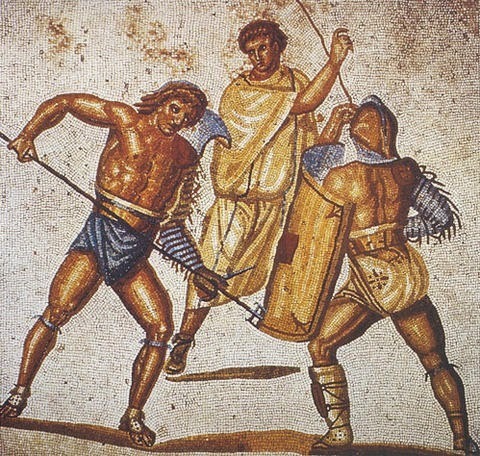MaryAnn Bernal's Blog, page 250
August 8, 2014
Silchester Roman town closes: 'nothing left except gravel and natural geology'
Maev Kennedy
Public invited in to abandoned town for last time to discover this year's best archaeological finds as excavation comes to an end
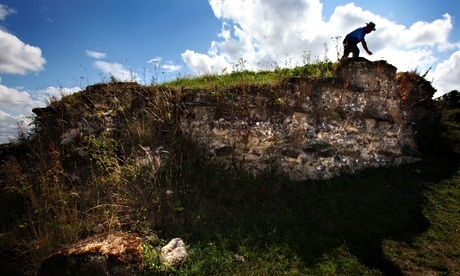
Professor Mike Fulford at Silchester. Fulford said: 'The site is being closed even if I have to take my little spade and spend the winter backfilling it myself.' Photograph: Graham Turner for the GuardianMuch as it must have been 1,400 years ago, the last inhabitants of Silchester, the most enigmatic Roman town in Britain, are packing their bags and preparing to leave for ever. This time, however, those departing are archeologists, and they go with the mystery of why a major town was abandoned in the sixth century still unsolved.
"Omnibus rebus bonis finis est," one student archaeologist has written in felt tip on the plywood wall of the ramshackle shower block: all good things come to an end.
Silchester, on a low hill near Basingstoke in Hampshire, was first dug up by the Victorians. For the last 18 years staff and students from Reading University have excavated Insula IX, a single block of the wider site, producing sensational finds, including the oldest olive stone ever found in Britain – from the Iron Age, revealing the previously unimagined fact that some people in Britain were eating olives before the Roman invasion – and a penknife intricately carved with a pair of mating dogs.
Dogs became one of the many puzzles: finds included little bones with flay marks indicating a flourishing industry in puppy fur cloaks, as well as ritual burials of ravens and a cat stuffed into a jar, the bones of a tiny lap dog and of another dog found standing up, still on guard after 2,000 years.
The public is invited in for one last open day on Saturday, when there will be tours, craft demonstrations, and displays of this year's best finds, including a red pottery bowl as immaculate as if made yesterday, a massive thumb ring with an enamel inlay, and a copper alloy bottle opener, which proved to be the folding handle of a Roman soldier's skillet – apart from the decoration, almost identical to a first world war mess tin handle.
And then it's over. There's a week of tidying up, and another week or two to clear out, but the excavation of Insula IX, on which more than 4,500 archaeology students from Reading University and across the world have learned their trade, is finished. A small mountain, a spoil heap estimated at 6,000 tonnes, stands waiting to be backfilled into the site.
"Nothing left there except gravel and natural geology," said professor Mike Fulford, who has been excavating at the site for 40 years, and leading the annual training excavations since 1997. "Nothing of any interest whatsoever."
In the 19th century the site, Roman Calleva Atrebatum, produced magnificent finds now on display at Reading museum, including superb mosaics and one of the most famous Roman finds in Britain, a gilt bronze eagle which inspired the novel The Eagle of the Ninth, and the film The Eagle.
The Reading team went back in to reopen the Victorian trenches and see what they'd missed: most of the story, it turned out.
Fulford set out to solve two puzzles: when the town was built and by whom, and when it was abandoned and why. He's pretty sure he cracked the first one. The town was at its height in the Iron Age, in the century before the Romans arrived in AD 43 – bringing with them, as every school child used to be taught, town planning and the first towns.
He believes it was founded around 50BC by Commius, a leader of the Atrobates tribe, who fell out with his Roman allies and had to leave Gaul sharpish. On his defensible hilltop, near the navigable rivers Kennet and Thames, with neat building plots along well-made roads and alleys, his people were trading in grain, metalwork, hunting dogs, and almost certainly slaves, to pay for luxury imports including jewellery, glassware, delicate pottery from France, olive oil and wine.
In the last week the university team finished excavating the outline of what may be the largest Iron Age hall ever found in Britain, 8m by 50m, a massive building which could even have been the home of Commius. They also found a beautiful Iron Age brooch deliberately deposited in the foundations.
The first Roman buildings were light military structures, and within 20 years the town was burnt down, possibly in the Boudiccan rebellion. It was rebuilt, with splendid civic buildings, but was never as large or as prosperous again.
A new trench opened this year on another section of the site showed the same pattern. What had been a large and imposing Roman building, with a colonnade, and a tile roof stamped with the emblem of the emperor Nero who may have paid for it, was abandoned in less than a generation, the site levelled and never re-used.
In the sixth century the town was very deliberately abandoned: the many wells were tumbled in, and the land gradually reverted to green fields, the buried town marked only by the jagged outline of massive walls which once formed a 1.5-mile circuit.
Why? Fulford said: "I suspect it was squeezed out between the rise of the rival kingdoms of Mercia and Wessex, but why was the site never re-used? I don't know. It remains a mystery."
Now it's over, he says – absolutely, definitely over. He wants to get back to his quiet office and start writing up the mammoth project, a task which will take years.
"That site is being closed even if I have to take my little spade and spend the winter backfilling it myself," he declared. And then he looked thoughtfully towards his new hole in the ground, and the lines of that giant Roman building running away under the undisturbed green fields, and added: "Though I wouldn't mind another quick look at that one day."
http://www.theguardian.com/uk-news/2014/aug/08/silchester-roman-town-closes-natural-geology-archaeological-excavation-ends
Public invited in to abandoned town for last time to discover this year's best archaeological finds as excavation comes to an end

Professor Mike Fulford at Silchester. Fulford said: 'The site is being closed even if I have to take my little spade and spend the winter backfilling it myself.' Photograph: Graham Turner for the GuardianMuch as it must have been 1,400 years ago, the last inhabitants of Silchester, the most enigmatic Roman town in Britain, are packing their bags and preparing to leave for ever. This time, however, those departing are archeologists, and they go with the mystery of why a major town was abandoned in the sixth century still unsolved.
"Omnibus rebus bonis finis est," one student archaeologist has written in felt tip on the plywood wall of the ramshackle shower block: all good things come to an end.
Silchester, on a low hill near Basingstoke in Hampshire, was first dug up by the Victorians. For the last 18 years staff and students from Reading University have excavated Insula IX, a single block of the wider site, producing sensational finds, including the oldest olive stone ever found in Britain – from the Iron Age, revealing the previously unimagined fact that some people in Britain were eating olives before the Roman invasion – and a penknife intricately carved with a pair of mating dogs.
Dogs became one of the many puzzles: finds included little bones with flay marks indicating a flourishing industry in puppy fur cloaks, as well as ritual burials of ravens and a cat stuffed into a jar, the bones of a tiny lap dog and of another dog found standing up, still on guard after 2,000 years.
The public is invited in for one last open day on Saturday, when there will be tours, craft demonstrations, and displays of this year's best finds, including a red pottery bowl as immaculate as if made yesterday, a massive thumb ring with an enamel inlay, and a copper alloy bottle opener, which proved to be the folding handle of a Roman soldier's skillet – apart from the decoration, almost identical to a first world war mess tin handle.
And then it's over. There's a week of tidying up, and another week or two to clear out, but the excavation of Insula IX, on which more than 4,500 archaeology students from Reading University and across the world have learned their trade, is finished. A small mountain, a spoil heap estimated at 6,000 tonnes, stands waiting to be backfilled into the site.
"Nothing left there except gravel and natural geology," said professor Mike Fulford, who has been excavating at the site for 40 years, and leading the annual training excavations since 1997. "Nothing of any interest whatsoever."
In the 19th century the site, Roman Calleva Atrebatum, produced magnificent finds now on display at Reading museum, including superb mosaics and one of the most famous Roman finds in Britain, a gilt bronze eagle which inspired the novel The Eagle of the Ninth, and the film The Eagle.
The Reading team went back in to reopen the Victorian trenches and see what they'd missed: most of the story, it turned out.
Fulford set out to solve two puzzles: when the town was built and by whom, and when it was abandoned and why. He's pretty sure he cracked the first one. The town was at its height in the Iron Age, in the century before the Romans arrived in AD 43 – bringing with them, as every school child used to be taught, town planning and the first towns.
He believes it was founded around 50BC by Commius, a leader of the Atrobates tribe, who fell out with his Roman allies and had to leave Gaul sharpish. On his defensible hilltop, near the navigable rivers Kennet and Thames, with neat building plots along well-made roads and alleys, his people were trading in grain, metalwork, hunting dogs, and almost certainly slaves, to pay for luxury imports including jewellery, glassware, delicate pottery from France, olive oil and wine.
In the last week the university team finished excavating the outline of what may be the largest Iron Age hall ever found in Britain, 8m by 50m, a massive building which could even have been the home of Commius. They also found a beautiful Iron Age brooch deliberately deposited in the foundations.
The first Roman buildings were light military structures, and within 20 years the town was burnt down, possibly in the Boudiccan rebellion. It was rebuilt, with splendid civic buildings, but was never as large or as prosperous again.
A new trench opened this year on another section of the site showed the same pattern. What had been a large and imposing Roman building, with a colonnade, and a tile roof stamped with the emblem of the emperor Nero who may have paid for it, was abandoned in less than a generation, the site levelled and never re-used.
In the sixth century the town was very deliberately abandoned: the many wells were tumbled in, and the land gradually reverted to green fields, the buried town marked only by the jagged outline of massive walls which once formed a 1.5-mile circuit.
Why? Fulford said: "I suspect it was squeezed out between the rise of the rival kingdoms of Mercia and Wessex, but why was the site never re-used? I don't know. It remains a mystery."
Now it's over, he says – absolutely, definitely over. He wants to get back to his quiet office and start writing up the mammoth project, a task which will take years.
"That site is being closed even if I have to take my little spade and spend the winter backfilling it myself," he declared. And then he looked thoughtfully towards his new hole in the ground, and the lines of that giant Roman building running away under the undisturbed green fields, and added: "Though I wouldn't mind another quick look at that one day."
http://www.theguardian.com/uk-news/2014/aug/08/silchester-roman-town-closes-natural-geology-archaeological-excavation-ends

Published on August 08, 2014 15:56
History Trivia - Roman emperor Trajan dies
August 8

70 The Tower of Antonia, military barracks built by Herod the Great in Jerusalem, and named after Herod's patron Mark Antony, was destroyed by Titus' army during the siege of Jerusalem.

117 Roman emperor Trajan died at Selinus (southern coast of Sicily) at age 63.
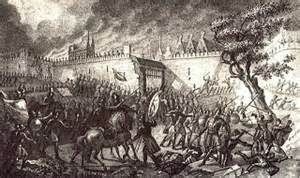
1220 Sweden was defeated by Estonian tribes in the Battle of Lihula. The short-lived Swedish attempt to gain a foothold in Estonia was motivated by the quickly advancing Danish and German crusaders who had been able to conquer most of the area in the early 13th century.

1503 King James IV of Scotland married Margaret Tudor, daughter of King Henry VII of England at Holyrood Abbey, Edinburgh, Scotland.


70 The Tower of Antonia, military barracks built by Herod the Great in Jerusalem, and named after Herod's patron Mark Antony, was destroyed by Titus' army during the siege of Jerusalem.

117 Roman emperor Trajan died at Selinus (southern coast of Sicily) at age 63.

1220 Sweden was defeated by Estonian tribes in the Battle of Lihula. The short-lived Swedish attempt to gain a foothold in Estonia was motivated by the quickly advancing Danish and German crusaders who had been able to conquer most of the area in the early 13th century.

1503 King James IV of Scotland married Margaret Tudor, daughter of King Henry VII of England at Holyrood Abbey, Edinburgh, Scotland.

Published on August 08, 2014 05:28
August 7, 2014
Richard III to be reburied at Leicester cathedral in March
Monarch's remains, which were discovered under a council car park in Leicester, to be reinterred following a week of events
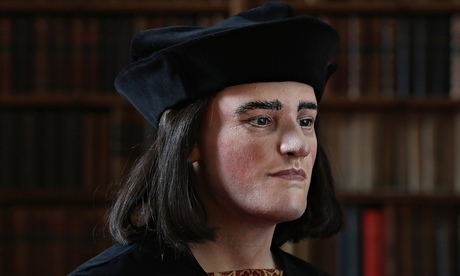
A facial reconstruction of Richard III, based on the remains discovered in Leicester in 2012. Photograph: Dan Kitwood/Getty ImagesRichard III will be reburied at Leicester cathedral next March, it has been announced.
The reinterment service will take place on 26 March following a week of events in Leicestershire to honour the monarch.
The remains will be placed in a lead-lined coffin at Leicester University on 22 March and will travel by hearse to Bosworth for a day of events marking the king's last movements.
The hearse will travel through villages that were significant to his final days before a service in Bosworth.
The king, who was crowned in 1483, was killed at the battle of Bosworth in August 1485.
The coffin will then return to Leicester cathedral in the early evening, where guests invited by David Monteith, the Dean of Leicester, will attend a reception service.
The monarch's remains will then lie in repose, his coffin covered with a commissioned pall, for three days to allow for members of the public to pay their respects.
The reinterment service, which will be by invitation only, will be broadcast live on Channel 4.
The Bishop of Leicester, the Rt Revd Tim Stevens, said: "Our cathedral has been consistently committed to providing a fitting, dignified and memorable ceremony for the reinterment of King Richard.
"We can now see how this works out in detail and our city and county look forward to all the events of next spring."
Archaeologists from the University of Leicester unearthed the king's remains in a council car park in Leicester in 2012.
Descendants of the monarch opposed the decision to reinter the remains in Leicester.
The group, called the Plantagenet Alliance, had called for a consultation and for the monarch to be buried in York.
They granted a judicial review, but in May judges at the high court ruled that there was no duty to consult over a final resting place.
http://www.theguardian.com/uk-news/2014/aug/07/richard-iii-reburied-leicester-cathedral-march


A facial reconstruction of Richard III, based on the remains discovered in Leicester in 2012. Photograph: Dan Kitwood/Getty ImagesRichard III will be reburied at Leicester cathedral next March, it has been announced.
The reinterment service will take place on 26 March following a week of events in Leicestershire to honour the monarch.
The remains will be placed in a lead-lined coffin at Leicester University on 22 March and will travel by hearse to Bosworth for a day of events marking the king's last movements.
The hearse will travel through villages that were significant to his final days before a service in Bosworth.
The king, who was crowned in 1483, was killed at the battle of Bosworth in August 1485.
The coffin will then return to Leicester cathedral in the early evening, where guests invited by David Monteith, the Dean of Leicester, will attend a reception service.
The monarch's remains will then lie in repose, his coffin covered with a commissioned pall, for three days to allow for members of the public to pay their respects.
The reinterment service, which will be by invitation only, will be broadcast live on Channel 4.
The Bishop of Leicester, the Rt Revd Tim Stevens, said: "Our cathedral has been consistently committed to providing a fitting, dignified and memorable ceremony for the reinterment of King Richard.
"We can now see how this works out in detail and our city and county look forward to all the events of next spring."
Archaeologists from the University of Leicester unearthed the king's remains in a council car park in Leicester in 2012.
Descendants of the monarch opposed the decision to reinter the remains in Leicester.
The group, called the Plantagenet Alliance, had called for a consultation and for the monarch to be buried in York.
They granted a judicial review, but in May judges at the high court ruled that there was no duty to consult over a final resting place.
http://www.theguardian.com/uk-news/2014/aug/07/richard-iii-reburied-leicester-cathedral-march

Published on August 07, 2014 13:30
Dinosaurs shrank to evolve into birds over 50m years
Ian Sample
Theropods underwent 12 stages of miniaturisation – from 163kg beasts to becoming the first birds on Earth, study finds
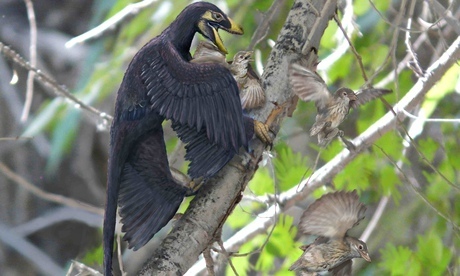
This is how the first feathered dinosaur, Microraptor, would have looked. It existed during the Cretaceous period, 120m years ago, in what is now northern China. Photograph: Brian Choo/Science Huge meat-eating dinosaurs shrank steadily over 50 million years to evolve into small, flying birds, researchers say.
The branch of theropod dinosaurs which gave rise to modern birds decreased inexorably in size from 163kg beasts that roamed the land, to birds weighing less than 1kg over the period.
The radical transformation began around 200m years ago and was likely driven by a move to the trees where creatures with smaller, lighter bodies and other features, such as large eyes for 3D vision, fared better than others.
Scientists pieced together the dinosaurs' sustained shrinkage after analysing more than 1,500 anatomical features of 120 species of theropods and early birds.
The evolutionary tree reveals that the theropod ancestors of modern birds underwent 12 substantial decreases in size that led to archaeopteryx, the earliest known bird on Earth. The rate at which they evolved distinct features, such as feathers, wings and wishbones, was four times faster than adaptations in other dinosaurs.
"Birds evolved through a unique phase of sustained miniaturisation in dinosaurs," said Michael Lee at the University of Adelaide. "Being smaller and lighter in the land of giants, with rapidly evolving anatomical adaptations, provided these bird ancestors with new ecological opportunities, such as the ability to climb trees, glide and fly. Ultimately, this evolutionary flexibility helped birds survive the deadly meteorite impact which killed off all their dinosaurian cousins," he added. The study is published in the journal, Science.
The steady reduction in size saw the two-legged land-based theropods evolve new bird-like features, including shorter snouts, smaller teeth and insulating feathers.
Gareth Dyke, a vertebrate palaeontologist and co-author of the study at Southampton University said: "The dinosaurs most closely related to birds are all small, and many of them, such as the aptly named Microraptor, had some ability to climb and glide."
In an accompanying article, Michael Benton at Bristol University, said that the long-term trend that led to modern birds was probably shaped by the animals taking up in new habitats. "The crucial driver may have been a move to the trees, perhaps to escape from predation or to exploit new food resources," he writes.
A smaller body size would have benefited animals living in the trees, while enlarged eyes would improve their 3D vision to avoid collisions with branches. Insulating feathers could have helped them hunt at night, and elongated forelimbs gave them increasingly more impressive wings to enable more daring leaps from tree to tree, Benton writes
http://www.theguardian.com/science/2014/aug/01/dinosaurs-shrank-birds-theropods-earth
Theropods underwent 12 stages of miniaturisation – from 163kg beasts to becoming the first birds on Earth, study finds

This is how the first feathered dinosaur, Microraptor, would have looked. It existed during the Cretaceous period, 120m years ago, in what is now northern China. Photograph: Brian Choo/Science Huge meat-eating dinosaurs shrank steadily over 50 million years to evolve into small, flying birds, researchers say.
The branch of theropod dinosaurs which gave rise to modern birds decreased inexorably in size from 163kg beasts that roamed the land, to birds weighing less than 1kg over the period.
The radical transformation began around 200m years ago and was likely driven by a move to the trees where creatures with smaller, lighter bodies and other features, such as large eyes for 3D vision, fared better than others.
Scientists pieced together the dinosaurs' sustained shrinkage after analysing more than 1,500 anatomical features of 120 species of theropods and early birds.
The evolutionary tree reveals that the theropod ancestors of modern birds underwent 12 substantial decreases in size that led to archaeopteryx, the earliest known bird on Earth. The rate at which they evolved distinct features, such as feathers, wings and wishbones, was four times faster than adaptations in other dinosaurs.
"Birds evolved through a unique phase of sustained miniaturisation in dinosaurs," said Michael Lee at the University of Adelaide. "Being smaller and lighter in the land of giants, with rapidly evolving anatomical adaptations, provided these bird ancestors with new ecological opportunities, such as the ability to climb trees, glide and fly. Ultimately, this evolutionary flexibility helped birds survive the deadly meteorite impact which killed off all their dinosaurian cousins," he added. The study is published in the journal, Science.
The steady reduction in size saw the two-legged land-based theropods evolve new bird-like features, including shorter snouts, smaller teeth and insulating feathers.
Gareth Dyke, a vertebrate palaeontologist and co-author of the study at Southampton University said: "The dinosaurs most closely related to birds are all small, and many of them, such as the aptly named Microraptor, had some ability to climb and glide."
In an accompanying article, Michael Benton at Bristol University, said that the long-term trend that led to modern birds was probably shaped by the animals taking up in new habitats. "The crucial driver may have been a move to the trees, perhaps to escape from predation or to exploit new food resources," he writes.
A smaller body size would have benefited animals living in the trees, while enlarged eyes would improve their 3D vision to avoid collisions with branches. Insulating feathers could have helped them hunt at night, and elongated forelimbs gave them increasingly more impressive wings to enable more daring leaps from tree to tree, Benton writes
http://www.theguardian.com/science/2014/aug/01/dinosaurs-shrank-birds-theropods-earth

Published on August 07, 2014 12:50
Neanderthals ate barbecued pigeon
Ian Sample
Charred bones suggest our ancient relatives cooked the ancestors of feral pigeons on the embers of their fires
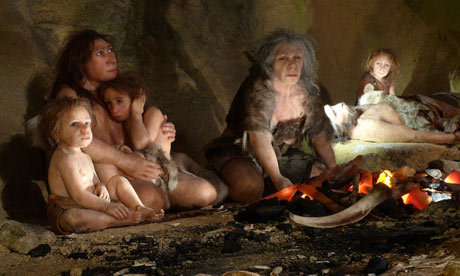
Neanderthals living near the sea in Gibraltar are known to have eaten seals, dolphins, shellfish – and now pigeon. Photograph: Nikola Solic/ReutersNeanderthals snacked on pigeons that they had toasted on open fires, according to researchers, adding to the menu of foods known to be eaten by our closest ancient relatives.
Leftovers of Neanderthal feasts were discovered in sediments that built up over millennia in the huge Gorham's Cave on the east face of Gibraltar, where generations of Neanderthals sheltered for nearly 100,000 years.
Workers at the site unearthed a haul of pigeon bones and found that some bore tooth marks, cuts from stone tools or signs of charring, perhaps created when the meat was left to cook on the glowing embers of a fire.
Most of the tell-tale marks were on pigeon wing and leg bones where much of the meat was to be had. Some of the thicker bones had tiny puncture marks from smaller, needle-like bones, which can happen when chicken wings are twisted apart to get at the meat.
The findings add to a growing body of evidence that Neanderthals had more on their minds at dinner time than large mammals. Those living in the caves of Gibraltar left behind butchered bones from seals and dolphins, and even had shucks for prising open shellfish.
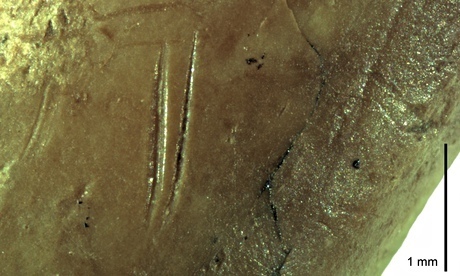 A rock dove bone with cut marks found in Gorham’s Cave. Photograph: Ruth Blasco et al/Scientific Reports "The picture that is emerging is that Neanderthals had a diverse larder outside their cave window and they were exploiting all these things," said Clive Finlayson, director of the Gibraltar Museum, who took part in the latest study. In June, researchers at MIT reported evidence from 50,000-year-old Neanderthal poo that those living in southern Spain ate plants too.
A rock dove bone with cut marks found in Gorham’s Cave. Photograph: Ruth Blasco et al/Scientific Reports "The picture that is emerging is that Neanderthals had a diverse larder outside their cave window and they were exploiting all these things," said Clive Finlayson, director of the Gibraltar Museum, who took part in the latest study. In June, researchers at MIT reported evidence from 50,000-year-old Neanderthal poo that those living in southern Spain ate plants too.
Finlayson's team decided to check whether birds were on the menu after they unearthed piles of bird bones at Gorham's Cave, where excavations have been going on for the past 25 years. At the latest count, 150 ancient bird species had been identified from bones found in the cave sediments.
Today, the cave sits squarely on the shore, beneath a spectacular cliff face that rises up more than 400 metres. But when Neanderthals occupied the cave, sea levels were lower and the sea may have been several kilometres away. From the entrance, the occupants would have looked out on a sandy plain broken up by wetlands and open areas where stone pine and juniper grew.
The majority of bird bones at Gorham's Cave belong to rock doves, the wild ancestors of modern feral pigeons. For the latest study, the researchers looked at 1,724 rock dove bones found in sediments ranging from 67,000 to 28,000 years old.
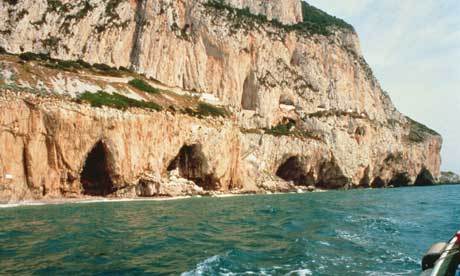 Caves on the east face of Gibraltar. All have evidence of Neanderthal occupation. Photograph: Natural History Museum, London Close examination of the bones found cut marks on 28 pigeon bones and tooth marks on 15 that dated from Neanderthal times. Other bones had burn marks. The more recent remains had similar marks made by modern humans who lived in the cave when the Neanderthals died out. While only a small portion of the bones had human marks, Finlayson said even those were unexpected.
Caves on the east face of Gibraltar. All have evidence of Neanderthal occupation. Photograph: Natural History Museum, London Close examination of the bones found cut marks on 28 pigeon bones and tooth marks on 15 that dated from Neanderthal times. Other bones had burn marks. The more recent remains had similar marks made by modern humans who lived in the cave when the Neanderthals died out. While only a small portion of the bones had human marks, Finlayson said even those were unexpected.
"When you consider that pigeons are quite small, it is amazing that any cut marks should appear," he said. Neanderthals could have pulled pigeons apart, unlike larger animals, without needing to cut them up first. "Maybe they are defleshing the animal and the stone knife slips and leaves a mark," he added.
Burn marks left some of the bones unevenly discoloured, which may have happened when wing or leg bones were cooked. "We think they are putting them on embers in the fire. If you have a bone with lots of muscle on one side, the bone more exposed to the fire becomes more cremated," said Finlayson.
The researchers say the oldest bones they studied cannot have been damaged by modern humans. "There is absolutely no doubt that this was the Neanderthals. And they could not have learned this from modern humans because there weren't any modern humans in Europe 67,000 years ago. They must have come up with this on their own," Finlayson said. A report on the work entitled "The earliest pigeon fanciers" appears in Nature Scientific Reports.
What the scientists cannot explain is how they managed to bag so many birds. Rock doves nest on cliff faces and the Neanderthals may have climbed up and raided the birds' nests. But Finlayson is doubtful of that: there are simply too many bones, he said.
 Rock doves are the ancestors of feral pigeons, which nowadays are more likely to be fed than eaten. Photograph: Scott Barbour/Getty Images "I'm speculating, but I think they must have had snares or nets or some other trapping techniques that were made from perishable materials such as grasses and fibres," he said. "But it would be very difficult to find traces of those."
Rock doves are the ancestors of feral pigeons, which nowadays are more likely to be fed than eaten. Photograph: Scott Barbour/Getty Images "I'm speculating, but I think they must have had snares or nets or some other trapping techniques that were made from perishable materials such as grasses and fibres," he said. "But it would be very difficult to find traces of those."
Researchers now plan to examine thousands of other bones unearthed at the site to see if Neanderthals were partial to other kinds of feathered food.
http://www.theguardian.com/science/2014/aug/07/neanderthals-barbecued-pigeon-gibraltar

Charred bones suggest our ancient relatives cooked the ancestors of feral pigeons on the embers of their fires

Neanderthals living near the sea in Gibraltar are known to have eaten seals, dolphins, shellfish – and now pigeon. Photograph: Nikola Solic/ReutersNeanderthals snacked on pigeons that they had toasted on open fires, according to researchers, adding to the menu of foods known to be eaten by our closest ancient relatives.
Leftovers of Neanderthal feasts were discovered in sediments that built up over millennia in the huge Gorham's Cave on the east face of Gibraltar, where generations of Neanderthals sheltered for nearly 100,000 years.
Workers at the site unearthed a haul of pigeon bones and found that some bore tooth marks, cuts from stone tools or signs of charring, perhaps created when the meat was left to cook on the glowing embers of a fire.
Most of the tell-tale marks were on pigeon wing and leg bones where much of the meat was to be had. Some of the thicker bones had tiny puncture marks from smaller, needle-like bones, which can happen when chicken wings are twisted apart to get at the meat.
The findings add to a growing body of evidence that Neanderthals had more on their minds at dinner time than large mammals. Those living in the caves of Gibraltar left behind butchered bones from seals and dolphins, and even had shucks for prising open shellfish.
 A rock dove bone with cut marks found in Gorham’s Cave. Photograph: Ruth Blasco et al/Scientific Reports "The picture that is emerging is that Neanderthals had a diverse larder outside their cave window and they were exploiting all these things," said Clive Finlayson, director of the Gibraltar Museum, who took part in the latest study. In June, researchers at MIT reported evidence from 50,000-year-old Neanderthal poo that those living in southern Spain ate plants too.
A rock dove bone with cut marks found in Gorham’s Cave. Photograph: Ruth Blasco et al/Scientific Reports "The picture that is emerging is that Neanderthals had a diverse larder outside their cave window and they were exploiting all these things," said Clive Finlayson, director of the Gibraltar Museum, who took part in the latest study. In June, researchers at MIT reported evidence from 50,000-year-old Neanderthal poo that those living in southern Spain ate plants too.Finlayson's team decided to check whether birds were on the menu after they unearthed piles of bird bones at Gorham's Cave, where excavations have been going on for the past 25 years. At the latest count, 150 ancient bird species had been identified from bones found in the cave sediments.
Today, the cave sits squarely on the shore, beneath a spectacular cliff face that rises up more than 400 metres. But when Neanderthals occupied the cave, sea levels were lower and the sea may have been several kilometres away. From the entrance, the occupants would have looked out on a sandy plain broken up by wetlands and open areas where stone pine and juniper grew.
The majority of bird bones at Gorham's Cave belong to rock doves, the wild ancestors of modern feral pigeons. For the latest study, the researchers looked at 1,724 rock dove bones found in sediments ranging from 67,000 to 28,000 years old.
 Caves on the east face of Gibraltar. All have evidence of Neanderthal occupation. Photograph: Natural History Museum, London Close examination of the bones found cut marks on 28 pigeon bones and tooth marks on 15 that dated from Neanderthal times. Other bones had burn marks. The more recent remains had similar marks made by modern humans who lived in the cave when the Neanderthals died out. While only a small portion of the bones had human marks, Finlayson said even those were unexpected.
Caves on the east face of Gibraltar. All have evidence of Neanderthal occupation. Photograph: Natural History Museum, London Close examination of the bones found cut marks on 28 pigeon bones and tooth marks on 15 that dated from Neanderthal times. Other bones had burn marks. The more recent remains had similar marks made by modern humans who lived in the cave when the Neanderthals died out. While only a small portion of the bones had human marks, Finlayson said even those were unexpected."When you consider that pigeons are quite small, it is amazing that any cut marks should appear," he said. Neanderthals could have pulled pigeons apart, unlike larger animals, without needing to cut them up first. "Maybe they are defleshing the animal and the stone knife slips and leaves a mark," he added.
Burn marks left some of the bones unevenly discoloured, which may have happened when wing or leg bones were cooked. "We think they are putting them on embers in the fire. If you have a bone with lots of muscle on one side, the bone more exposed to the fire becomes more cremated," said Finlayson.
The researchers say the oldest bones they studied cannot have been damaged by modern humans. "There is absolutely no doubt that this was the Neanderthals. And they could not have learned this from modern humans because there weren't any modern humans in Europe 67,000 years ago. They must have come up with this on their own," Finlayson said. A report on the work entitled "The earliest pigeon fanciers" appears in Nature Scientific Reports.
What the scientists cannot explain is how they managed to bag so many birds. Rock doves nest on cliff faces and the Neanderthals may have climbed up and raided the birds' nests. But Finlayson is doubtful of that: there are simply too many bones, he said.
 Rock doves are the ancestors of feral pigeons, which nowadays are more likely to be fed than eaten. Photograph: Scott Barbour/Getty Images "I'm speculating, but I think they must have had snares or nets or some other trapping techniques that were made from perishable materials such as grasses and fibres," he said. "But it would be very difficult to find traces of those."
Rock doves are the ancestors of feral pigeons, which nowadays are more likely to be fed than eaten. Photograph: Scott Barbour/Getty Images "I'm speculating, but I think they must have had snares or nets or some other trapping techniques that were made from perishable materials such as grasses and fibres," he said. "But it would be very difficult to find traces of those."Researchers now plan to examine thousands of other bones unearthed at the site to see if Neanderthals were partial to other kinds of feathered food.
http://www.theguardian.com/science/2014/aug/07/neanderthals-barbecued-pigeon-gibraltar

Published on August 07, 2014 12:44
Ancient Discoveries - Galen, Doctor to the Gladiators
Published on August 07, 2014 05:40
History Trivia - Macbeth was performed at the Great Hall at Hampton Court
August 7
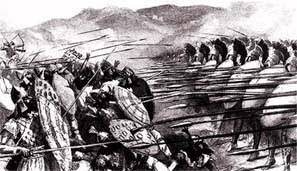
322 BC Battle of Crannon: Macedonian forces of Antipater and Craterus and rebellious Greek forces led by the Athenians, was the decisive battle of the Lamian War, following the death of Alexander the Great. The Greeks sued for peace which marked the end of city-state freedom from Macedonian hegemony in Greece.

317 Roman Emperor Flavius Julius Constantius was born.

626 The Avar and Slav armies left the siege of Constantinople, which kept the Byzantine Empire intact.
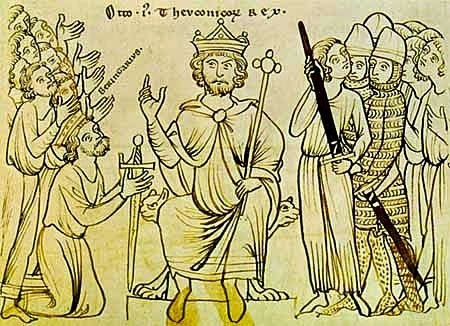
936 Coronation of King Otto I of Germany. He would become the first Holy Roman Emperor since Charlemagne.

1420 Construction of the dome of Santa Maria del Fiore began in Florence.
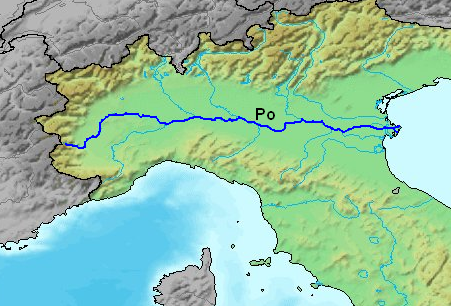
1427 The Visconti of Milan's fleet was destroyed by the Venetians on the Po River.

1485 Henry VII's army landed in Milford Harbor, South-Wales, a Lancastrian stronghold, and amassed an army to seize the crown from Richard III who was defeated at the Battle of Bosworth Field on August 22, 1485.

1606 The first documented performance of Macbeth was performed at the Great Hall at Hampton Court.


322 BC Battle of Crannon: Macedonian forces of Antipater and Craterus and rebellious Greek forces led by the Athenians, was the decisive battle of the Lamian War, following the death of Alexander the Great. The Greeks sued for peace which marked the end of city-state freedom from Macedonian hegemony in Greece.

317 Roman Emperor Flavius Julius Constantius was born.

626 The Avar and Slav armies left the siege of Constantinople, which kept the Byzantine Empire intact.

936 Coronation of King Otto I of Germany. He would become the first Holy Roman Emperor since Charlemagne.

1420 Construction of the dome of Santa Maria del Fiore began in Florence.

1427 The Visconti of Milan's fleet was destroyed by the Venetians on the Po River.

1485 Henry VII's army landed in Milford Harbor, South-Wales, a Lancastrian stronghold, and amassed an army to seize the crown from Richard III who was defeated at the Battle of Bosworth Field on August 22, 1485.

1606 The first documented performance of Macbeth was performed at the Great Hall at Hampton Court.

Published on August 07, 2014 05:38
August 6, 2014
History Trivia - Genoa loses its naval dominance in the Mediterranean
August 6

258 Pope Sixtus II was beheaded during the persecution by Emperor Valerian.
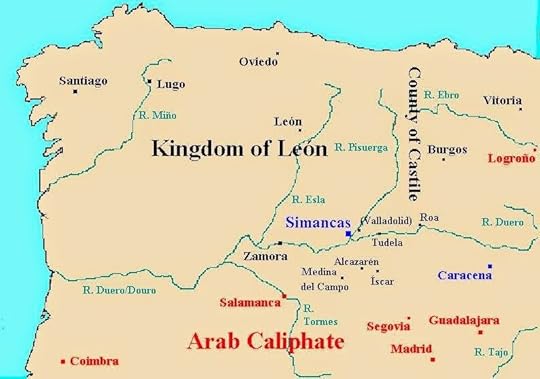
939 Battle at Simancas - Spain defeated the Moors. Arab witnesses reported a spectacular eclipse of the sun that took place on the first day of the battle, a bad omen.

1181 Supernova was observed by Chinese and Japanese astronomers.
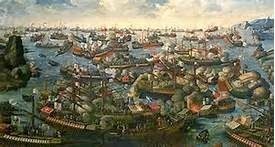
1284 The Republic of Pisa was defeated in the Battle of Meloria by the Republic of Genoa, thus losing its naval dominance in the Mediterranean.

1806 Francis II, the last Holy Roman Emperor, abdicated, ending the Holy Roman Empire.


258 Pope Sixtus II was beheaded during the persecution by Emperor Valerian.

939 Battle at Simancas - Spain defeated the Moors. Arab witnesses reported a spectacular eclipse of the sun that took place on the first day of the battle, a bad omen.

1181 Supernova was observed by Chinese and Japanese astronomers.

1284 The Republic of Pisa was defeated in the Battle of Meloria by the Republic of Genoa, thus losing its naval dominance in the Mediterranean.

1806 Francis II, the last Holy Roman Emperor, abdicated, ending the Holy Roman Empire.

Published on August 06, 2014 04:18
August 5, 2014
First World War 100th Anniversary 2014-2018 - a tribute
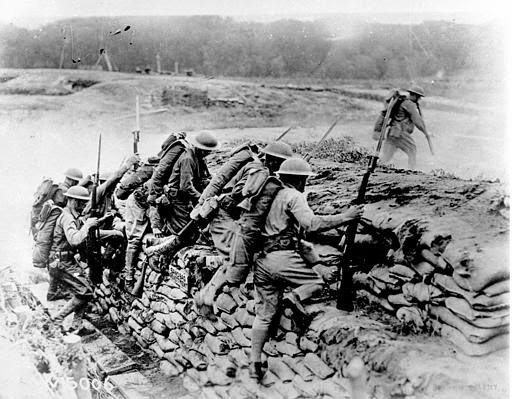
First World War 100th Anniversary 2014-2018
This is a tribute to all those poor souls who fought and died during WWI using historical footage and voice recordings mostly from the documentaries Forgotten Voices of the Great War and Voices of the Great war. A special thank you to KingofClapham for providing me some footage from his documentary. I know it is still a couple months till memorial day but I decided to make this video never the less. From the Germans to the French. From the Turks to the Aussies. The British, The Canadians, the Americans, the Russians, the Austrians and everyone else.

Published on August 05, 2014 08:43
Undeserving: (Novella 1 in the Someone To Love Me trilogy) by Gladys Quintal - Kindle Edition FREE

All of her life, Bree had been treated badly by men. According to her mother, it was just the way it was with the women in her family and there was no point in trying to fight it. There was no sense in dreaming about Prince Charming right out of the story books, he just didn't exist. She had to accept her fate and move on. It was as simple as that.
Bree craved love. She longed for a man to promise her his heart and soul and protect her from the monsters that she had grown accustomed to. She prayed that her mother was wrong and that one day he would find her.
Amazon Link
http://www.amazon.com/dp/B00M2ZWJGO/ref=cm_sw_r_tw_dp_L653tb0S8125H

Published on August 05, 2014 07:48

